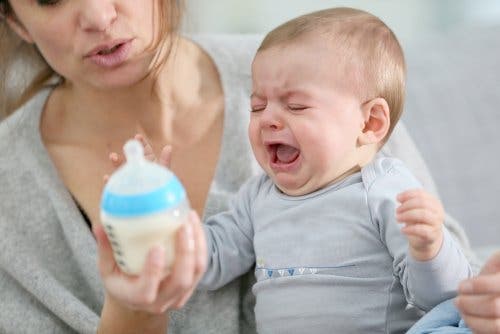The Negative Effects of Anxious Attachment

Imagine that each time you turn to your loved ones for support, you get a different response. On some occasions, they are understanding and loving with you. Other times, however, they ignore you to even become angry because you bothered them. Can you imagine how alone, lost, and confused you would feel? This is the damage that anxious attachment causes in children who experience it.
What is attachment?
Attachment is the bond that forms between babies and their mothers (or main caretaker) in order to guarantee the child’s survival. Human babies are completely defenseless and totally dependent. Therefore, the bond they establish with their carers helps them to survive and develop properly.
Attachment forms during the first three months of life and forges in children an unconscious representation of affective relationships. The quality of the social interaction that children develop will depend on this early learning experience. And this is why anxious attachment is so damaging.
What’s more, this internalized behavior pattern translates to the social relationships they establish as adolescents and adults. In other words, it affects people for their entire lives.

Attachment patterns
During the experiment, she observed the level of exploration of the environment that children displayed with their mothers present. She measured the same behavior when the mother left, and when she returned.
Based on the data she gathered, Ainsworth was able to establish four different types of attachment. These are secure, avoidant, disorganized, and anxious attachment. Each attachment type is the consequence of how the mother (or another attachment figure) responds to the baby’s needs. According to the emotional availability of the mother, the child will react in one way or another.
Anxious attachment
During Ainsworth’s experiment, some children demonstrated the damage of anxious attachment by means of very distinctive signs:
- These children demonstrated increased anxiety even when their mothers were present. They hardly explored their territory and remained constantly on alert, vigilant of their mothers.
- When their mothers left the room, the babies cried and searched for them desperately. They wouldn’t allow any other person to console them.
- As soon as their mothers returned, the children ran towards them for comfort but immediately rejected them.
Ainsworth discovered that the mothers of these children exercise a completely unstable and unpredictable response pattern. On occasion, they’re warm, close, and motherly. However, there are other times when they’re insensitive and closed off to the demands of their little ones.
The main cause of this maternal behavior is an internal conflict that the mother is dealing with. When her baby cries, she feels a mixture of rejection, hostility, and love for her little one. She’s not sure whether her child’s demands are real or if he or she is simply “pushing her buttons.”
At the same time, she’s not sure if she should go and console her child or not. Perhaps someone close to her told her she shouldn’t coddle her child. As a result of this uncertainty, she feels overwhelmed and begins to display erratic and inconsistent behavior.

Effects of anxious attachment
- Babies with anxious attachment experience constant anxiety. They display an intense need and, at the same time, a strong rejection of their mothers. Their anxiety also impedes them from being able to freely explore their environment. They may exaggerate their crying and demands in an attempt to get their mother’s attention.
- As they grow, they become children with low self-esteem and a lack of trust. They’ve learned that they’re unworthy of being loved and that they’re only appreciated when they’re not bothering anyone. What’s more, they’ve learned not to trust in the care and affection of anyone. They grow up with an intense fear of abandonment and the ambivalent feelings towards their mother continue.
- As adults, they establish a pattern of dependence in their relationships. They demand constant affection and attention and seek total fusion with their partners. What’s more, they feel panic in the face of any sign that their partners are pulling away. They’re prone to jealousy and distrust.
- Babies with anxious attachment become children and adults with a tremendous fear of abandonment and a great need for approval.
Imagine that each time you turn to your loved ones for support, you get a different response. On some occasions, they are understanding and loving with you. Other times, however, they ignore you to even become angry because you bothered them. Can you imagine how alone, lost, and confused you would feel? This is the damage that anxious attachment causes in children who experience it.
What is attachment?
Attachment is the bond that forms between babies and their mothers (or main caretaker) in order to guarantee the child’s survival. Human babies are completely defenseless and totally dependent. Therefore, the bond they establish with their carers helps them to survive and develop properly.
Attachment forms during the first three months of life and forges in children an unconscious representation of affective relationships. The quality of the social interaction that children develop will depend on this early learning experience. And this is why anxious attachment is so damaging.
What’s more, this internalized behavior pattern translates to the social relationships they establish as adolescents and adults. In other words, it affects people for their entire lives.

Attachment patterns
During the experiment, she observed the level of exploration of the environment that children displayed with their mothers present. She measured the same behavior when the mother left, and when she returned.
Based on the data she gathered, Ainsworth was able to establish four different types of attachment. These are secure, avoidant, disorganized, and anxious attachment. Each attachment type is the consequence of how the mother (or another attachment figure) responds to the baby’s needs. According to the emotional availability of the mother, the child will react in one way or another.
Anxious attachment
During Ainsworth’s experiment, some children demonstrated the damage of anxious attachment by means of very distinctive signs:
- These children demonstrated increased anxiety even when their mothers were present. They hardly explored their territory and remained constantly on alert, vigilant of their mothers.
- When their mothers left the room, the babies cried and searched for them desperately. They wouldn’t allow any other person to console them.
- As soon as their mothers returned, the children ran towards them for comfort but immediately rejected them.
Ainsworth discovered that the mothers of these children exercise a completely unstable and unpredictable response pattern. On occasion, they’re warm, close, and motherly. However, there are other times when they’re insensitive and closed off to the demands of their little ones.
The main cause of this maternal behavior is an internal conflict that the mother is dealing with. When her baby cries, she feels a mixture of rejection, hostility, and love for her little one. She’s not sure whether her child’s demands are real or if he or she is simply “pushing her buttons.”
At the same time, she’s not sure if she should go and console her child or not. Perhaps someone close to her told her she shouldn’t coddle her child. As a result of this uncertainty, she feels overwhelmed and begins to display erratic and inconsistent behavior.

Effects of anxious attachment
- Babies with anxious attachment experience constant anxiety. They display an intense need and, at the same time, a strong rejection of their mothers. Their anxiety also impedes them from being able to freely explore their environment. They may exaggerate their crying and demands in an attempt to get their mother’s attention.
- As they grow, they become children with low self-esteem and a lack of trust. They’ve learned that they’re unworthy of being loved and that they’re only appreciated when they’re not bothering anyone. What’s more, they’ve learned not to trust in the care and affection of anyone. They grow up with an intense fear of abandonment and the ambivalent feelings towards their mother continue.
- As adults, they establish a pattern of dependence in their relationships. They demand constant affection and attention and seek total fusion with their partners. What’s more, they feel panic in the face of any sign that their partners are pulling away. They’re prone to jealousy and distrust.
- Babies with anxious attachment become children and adults with a tremendous fear of abandonment and a great need for approval.
All cited sources were thoroughly reviewed by our team to ensure their quality, reliability, currency, and validity. The bibliography of this article was considered reliable and of academic or scientific accuracy.
- Ainsworth, M. D. S., Blehar, M. C., Waters, E., & Wall, S. N. (2015). Patterns of attachment: A psychological study of the strange situation. Psychology Press.
- Castelló, J. (2000). Análisis del concepto dependencia emocional. In I Congreso Virtual de Psiquiatría (Vol. 5, No. 8).
This text is provided for informational purposes only and does not replace consultation with a professional. If in doubt, consult your specialist.








